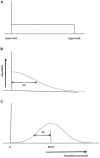Using Bayes to get the most out of non-significant results
- PMID: 25120503
- PMCID: PMC4114196
- DOI: 10.3389/fpsyg.2014.00781
Using Bayes to get the most out of non-significant results
Abstract
No scientific conclusion follows automatically from a statistically non-significant result, yet people routinely use non-significant results to guide conclusions about the status of theories (or the effectiveness of practices). To know whether a non-significant result counts against a theory, or if it just indicates data insensitivity, researchers must use one of: power, intervals (such as confidence or credibility intervals), or else an indicator of the relative evidence for one theory over another, such as a Bayes factor. I argue Bayes factors allow theory to be linked to data in a way that overcomes the weaknesses of the other approaches. Specifically, Bayes factors use the data themselves to determine their sensitivity in distinguishing theories (unlike power), and they make use of those aspects of a theory's predictions that are often easiest to specify (unlike power and intervals, which require specifying the minimal interesting value in order to address theory). Bayes factors provide a coherent approach to determining whether non-significant results support a null hypothesis over a theory, or whether the data are just insensitive. They allow accepting and rejecting the null hypothesis to be put on an equal footing. Concrete examples are provided to indicate the range of application of a simple online Bayes calculator, which reveal both the strengths and weaknesses of Bayes factors.
Keywords: Bayes factor; confidence interval; highest density region; null hypothesis; power; significance testing; statistical inference.
Figures



References
-
- American Psychological Association [APA] (2010). Publication Manual of the American Psychological Association 5th Edn. Washington, DC: AP.
-
- Armitage P., McPherson C. K., Rowe B. C. (1969). Repeated significance tests on accumulating data. J. R. Stat. Soc. Ser. A 132 235–244 10.2307/2343787 - DOI
LinkOut - more resources
Full Text Sources
Other Literature Sources

